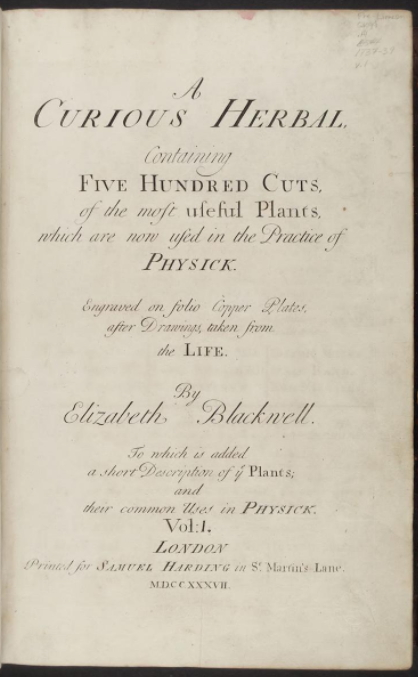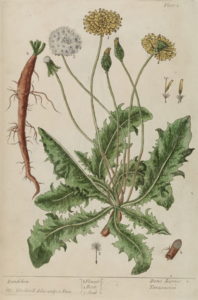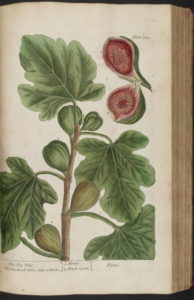One of my favorite on-line resources is the Internet Archive, a repository of books, music, movies, and more. It is a virtual library that I love to get lost in. There’s always something interesting to find.
Internet Archive is a non-profit library of millions of free books, movies, software, music, websites, and more.
The other day while perusing, I came across a beautiful book titled “A Curious Herbal: Containing Five Hundred Cuts of the most useful plants which are now useful in the practice of Physick,” by one Elizabeth Blackwell, a Scottish botanical illustrator. It was printed in London, England, for Samuel Harding, dated MDCCXXXVII (1737). It seems appropriate to mention this work in a website dealing with gardens and cultivation, and it is not really so curious to see how the common uses of herbs have held up over time and scientific scrutiny, as these same herbs and plants are still used for the same purposes today.

Elizabeth Blackwell (1707 –1758) was a Scottish botanical illustrator and author who was best known as both the artist and engraver for the plates of “A Curious Herbal”, published between 1737 and 1739. The book illustrated many odd-looking and unknown plants from the New World, and was designed as a reference work on medicinal plants for the use of physicians and apothecaries.
Wikipedia contributors, “Elizabeth Blackwell (illustrator),” Wikipedia, The Free Encyclopedia,https://en.wikipedia.org/w/index.php?title=Elizabeth_Blackwell_(illustrator)&oldid=788313721(accessed November 3, 2017).
The book presents a series of beautifully rendered color plates that include dandelion, mullein, rue, sage, stinging nettle, wormwood, primrose, fig, and dozens more–a total of 232 wonderfully rendered plates in this first volume alone. Below are a few excerpts from the book and corresponding plates showing Elizabeth’s delicate illustrations.
Elizabeth Blackwell’s introduction to “A Curious Herbal”:
The undertaker, being desirous to make this Work more useful to such as are not furnished with other Herbals, is resolved for their Sake to give a short Description of each Plant, the Place of Growth, and Time of Flowering, with its common uses in Physick, chiefly extracted from Mr. Joseph Miller’s Botanicum Officinale with his Consent, and the ordinary Names of the Plant in different Languages.
Excerpts from “A Curious Herbal”
Plate 1: Dandelion, or Pissa bed. Dens Leonis
- The Leaves of this Plant lie on the Ground, the Pedikels or Pipes on which the Flowers grow are about six or eight Inches high; and the flowers Yellow. The Root grows about a Finger thick, and eight Inches long, full of a white bitter Milk.
- It grows almost every where in Fallow Ground & flowers most months in the year.
- The Roots & Leaves are used as cooling aperative provoking Urine and strengthening the stomach and are much eat as a sallad in the Spring.
Plate 15: St. John’s Wort. Hypericum

- This Plant grows to be two Foot high; the Leaves when held up against the Light appear full of small Holes; the Flowers are a bright yellow, with a great Number of Apices and Stamina, which being bruised between the Fingers, emit a bloody Juice.
- It grows in Hedges and among Bushes and flowers in June and July.
- St. John’s Wort is accounted aperative, detersive, diuretic, alexipharmic; good in tertian and quartan Agues; destroys Worms and is an excellent vulnerary Plant. A Tincture of the Flowers in spirit of Wine is commended against Melancholy & Madness. Outwardly it is of great Service in Bruises, Contusions, and Wounds, especially in the nervous Parts. The officinal Preparations are the simple and compound Oil.
Plate 125: The Fig Tree. Ficus

- It seldome grows to be a Tree of any great Bigness in England, the Leaves are a grass Green and the Fruit when ripe of a brownish Green. It beareth no visible Flowers, which makes it believe they are hid in the Fruit.
- Its Native soils are Turky, Spain, and Portugal, and its time of Bearing is in Spring and Autumn; the Figs are cured by dipping them in scalding hot Lye, made of the Ashes of the Cuttings of the Tree and afterwards they dry them carefully in the Sun.
- Figs are esteem’d cooling and moistening, good for Coughs, shortness of Breath, and all Diseases of the Breast, and also the Stone and Gravel, and the small Pox and Measles, which they drive out. Outwardly they are dissolving and ripening, good for Imposthumations and Swellings and pestilential Buboes.
“A Curious Herbal” can be downloaded in various formats from the Internet Archive.
Find out more about the Internet Archive